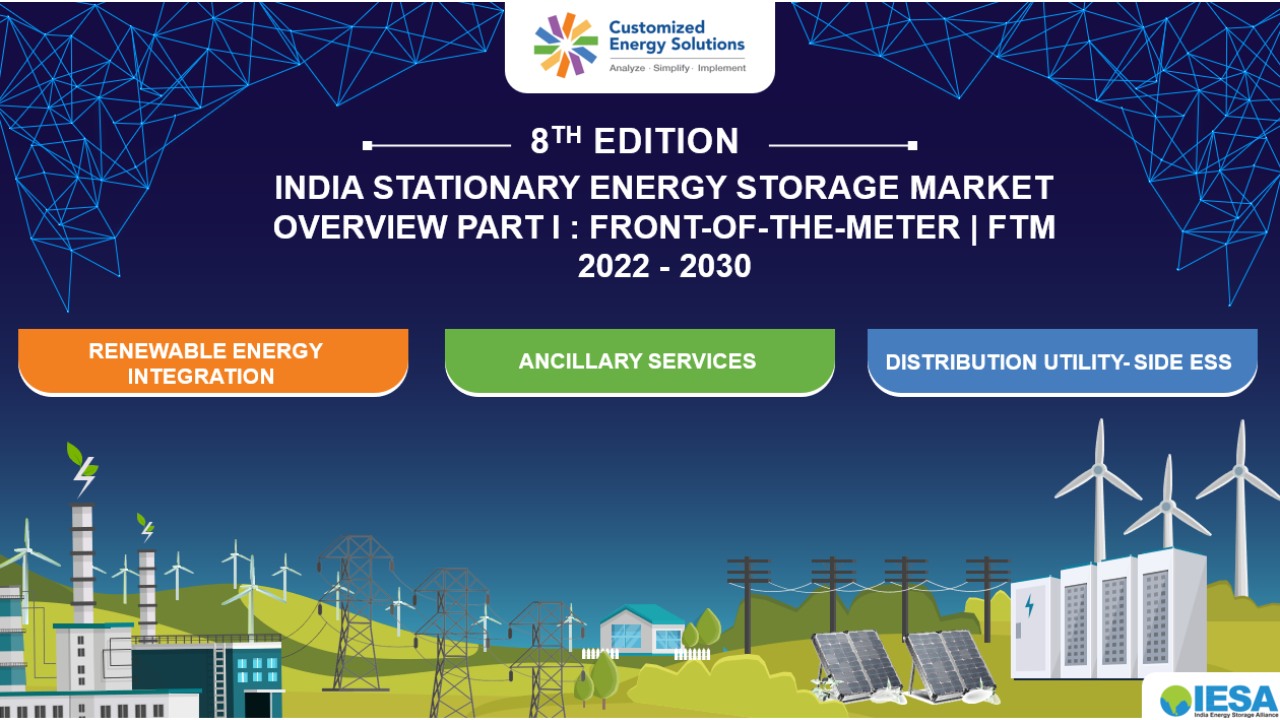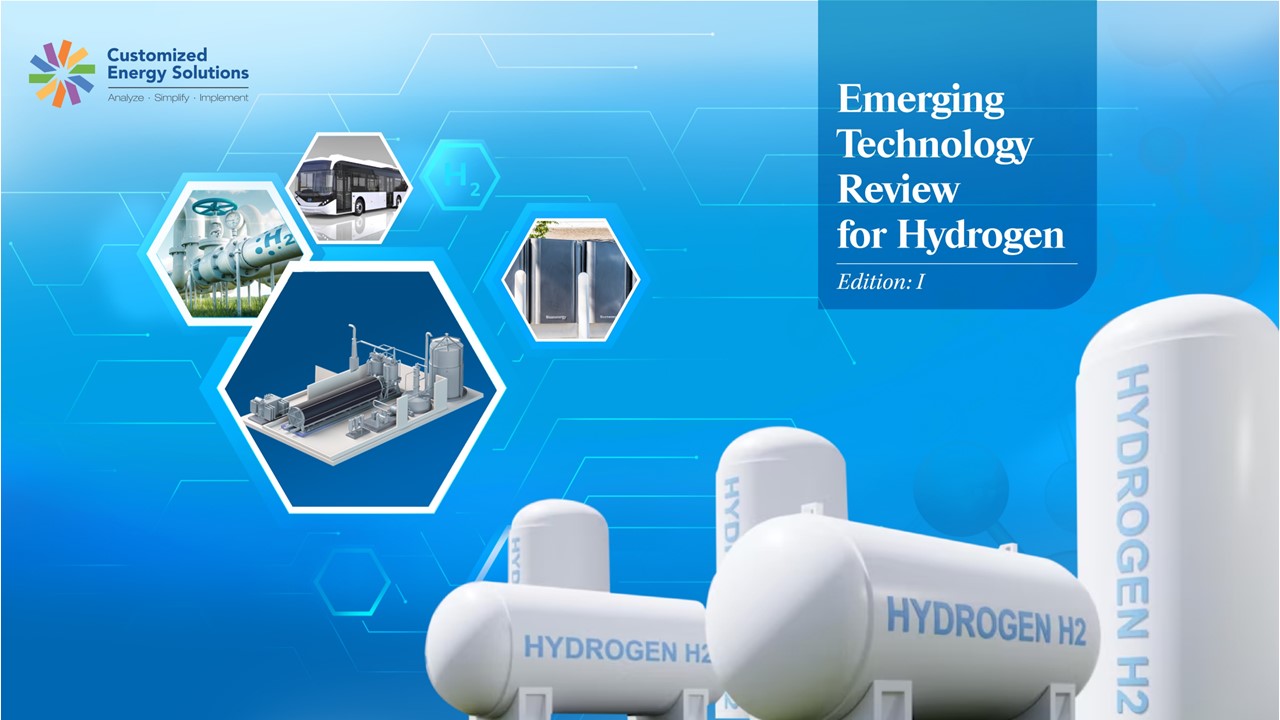Policy framework to accelerate ES deployment in India
Related information you may be interested in.

Emerging Technology Review(ETR) for E-mobility Edition 2
The world is undergoing an immense transition in one of the most key aspects governing our lives. It is in the generation, availability and use of energy which supports all dimensions of our existence. Food production, processing and delivery, infrastructure development, clothing industry, transportation, healthcare and any other activity crucial for our sustenance depends on energy. Over time we have become used to depending on fossil fuels for providing us this key supporting ingredient. It is this core enabler, which is undergoing transition. This transition has been made possible, in part due to the development of advanced technologies for energy storage and conversion. In this series of 4 reports, we attempt to cover all the major technologies which are either currently commercially available or those which are in the late development stages and will be commercially manufactured at scale in the next 3-5 years. All technologies for energy storage and conversion are constantly evolving and improving in performance owing to the ongoing efforts of the global academic and industrial community. In the current report which is the first in this series of reports, we cover all the technologies which are of interest for e-mobility applications. These applications can range from small personal transportation devices such as Segways and hoverboards to heavy duty vehicles such as trucks, trains and medium sized boats. We wish that through this report we are able to provide specific and to-the-point information to a wide range of audience who are interested in learning about these new technologies. The review is prepared keeping in mind that the readers may be from very different backgrounds and we hope that the concepts and information presented will help all decisions makers from industry as well as from the government. Table of Contents Motivation and Objectives of this Technology Review Executive Summary Classification of Applications for Mobility Electric vehicles (2W, 3W, 4W, Trucks and Buses) Long distance Transportation (small/medium sized boats, inter and intra city trains) Alternate mobility devices (bicycles, Segway, unicycles, drones, UAVs and hoverboards) Application specific requirements of Energy Storage Technologies Existing Technologies and major manufacturers of Storage for Mobility Applications Li-ion batteries Expected improvements in 3-5 years High voltage cathodes, high capacity anodes, high performance electrolytes, Li-S batteries Next Generation Technologies – Part I: Solid state batteries Construction and design Classification of SSBs Major OEM investments in SSB startups Product offerings of prominent SSB companies (Solid Energy, Solid Power, Prologium, Blue solutions, Sion Power) Next Generation Technologies – Part II: PEM Fuel Cells Comparison of Fuel Cell Technologies Green Hydrogen on-site Production: Electrolyzers Ongoing technological and manufacturing challenges PEMFCs for 4W, heavy vehicles and trains Key questions the report answers Which technologies are suitable for e-mobility applications and what improvements can be expected in the next 3-5 years? Which technologies are on the horizon and will be commercially manufactured an available soon? How are these technologies superior in performance to existing storage solutions? Which Solid state battery companies are at the forefront of developing new technologies? What are the recent developments and PEM fuel cells for e-mobility and which applications will they enter in the next 3-5 years?
Read More
India Electric Vehicle Market Overview Report 2023
India Electric Vehicle Market Overview 2022 & 2023 EV sales in India were recorded at 1.3 million for 2022, and are expected to touch 1.7 million units by the end of 2023 according to IESA’s projection as per business-as-usual scenario. EV market in India is expected to witness CAGR of 35% from 2023 to 2032 under business-as-usual scenario. The report covers market estimates and forecasts for India EV market by vehicle segments i.e. E-2 wheeler, E-3 wheeler, E-4 wheeler, E-bus and E-truck in terms of annual unit sales and annual battery demand (GWh). Factors driving EV market in India include: FAME-II subsidy Entry of large number of OEMs Auto components production liked incentive scheme Major push to replace ICE fleet with EVs However, EV market in India is currently facing challenges such as: High cost of EV Lack of public charging infrastructure Requirement of investment for power grid upgradation Absence of subsidy in some segments State governments in India are taking active steps through their respective EV policies to increase EV adoption, providing demand incentives such as subsidy on new EV purchase, road tax exemption, registration fee exemption, and scrapping and retrofit incentives. Incentives and support under state EV policies are centered around manufacturing, charging infrastructure, R&D, battery recycling, employment generation and skill development. For instance, states such as Tamil Nadu, Haryana, Andhra Pradesh and Uttar Pradesh are providing incentives to encourage investment both, EV manufacturing and component manufacturing, while also looking to aid local EV ecosystem in the state. EV Market Overview, 2022 E-2 wheeler segment witnessed EV sales of around 0.8 million in 2022, owing to low cost and increase in subsidy for this segment from June 2021 to May 2023. Under E-3 wheeler category, low-speed E-rickshaws held a dominant share over high-speed E-3 wheelers. However, new players have entered the high-speed E-3 wheeler category, providing more options to end users. E-4 wheeler adoption in India is driven by requirement of personal mobility and taxi fleet operators. In 2022, personal mobility dominated with around 87% market share, against 13% for fleet operators. However, sales for fleet operators have jumped four-fold in 2022 over 2021 numbers as attractive total cost of ownership prompted players such as Ola and Uber to begin replacing ICE vehicles with EVs. E-bus segment sales have been driven by subsidy available for the category, specifically for government end-use. Convergence Energy Services Ltd acts as the major tendering agency, and is working to deploy 50,000 E-buses under the National Electric Bus Program. E-truck is one of the newer segments in India, and therefore, sales are lowest compared with other EV segments in 2022, owing to limited product offerings by players and absence of subsidy. In terms of battery chemistries, lead acid is utilized for low-speed E-2 wheelers and low-speed E-rickshaws, while lithium-ion battery chemistries such as LFP and NMC are widely utilized in all other EV segments. Other lithium-ion chemistries such as NCA, LTO and LMO have witnessed limited application, with utilization only by certain specific players. Source: CES Analysis Additional Key Points Covered: India EV Market Drivers EV Market Developments by Segments, 2022-32 EV Battery Demand Forecast by Segment Competitive Landscape Total Cost of Ownership Analysis by EV Segments Central Level Policy & Regulations State EV Policies Who Should Buy the Report: Global EV OEMs EV Commercial Fleet Owner Government Agencies State Transport Utilities Financial Institution & Investors
Read More
Global ESS Policy Overview Whitepaper
Sustainability and net zero emissions are the most spoken words of the decade in the energy sector. Several nations across the globe have committed to net-zero emissions targets slated to be achieved by the year 2040 to 2070. The goal is to achieve these targets through renewable energy, energy storage, hydrogen, sustainable aviation fuels, modular nuclear, and suitable climate technologies. At the center of decarbonization efforts in the electricity, transportation, and industrial sectors are renewable energy and hydrogen (both blue and green). Due to the intermittent nature of renewable power, a round-the-clock supply of clean electricity necessitates the storage of electricity. Energy storage, therefore, is inevitable for grid electricity supply and stabilization, and for powering the critical technology of electrolyzers used for producing green hydrogen. There are several types of energy storage technologies that are being pilot-tested and adopted across the globe for a variety of applications ranging from electricity generation, transmission, and distribution, to backup at consumer sites. While pumped hydro energy storage has been traditionally used for energy storage and grid flexibilization applications, emerging technologies such as battery energy storage, flywheels, and compressed air storage are also being deployed for various use cases. This whitepaper intends to serve as a reference to regulators, utilities, and energy sector stakeholders to deepen their knowledge of global policies and electricity frameworks for energy storage systems that support the decarbonization of the electric grid.
Read More
India SES Market Overview Part I : FTM 2022 - 2030
RE integration to account for the maximum share of FTM energy storage application owing to large capacity tenders being announced by the Central and State agencies. Lithium-ion and pumped hydro are the two dominant ESS technologies being deployed in the country. Battery chemistries such as vanadium redox flow batteries, advanced lead acid batteries, and zinc bromide batteries are currently being tested by OEMs through pilot projects for grid-scale applications. India’s front-of-the-meter energy storage market is expected to witness an annual installation of around 20 GWh by 2030, according to India Stationary Energy Storage Market Overview Part I: Front-Of-The-Meter (FTM) 2022- 2030. Currently, the installed base of BESS for various chemistries in India is around 41 MWh. The report covers FTM energy storage applications for grid-scale renewable energy integration, DISCOM-side integration, and ancillary services. According to the report, the prime factors boosting the FTM energy storage market in India, include India’s ambitious RE targets, supportive government policies, and regulations along with RE tender issuance by government agencies such as Solar Energy Corporation of India (SECI), National Thermal Power Corporation (NTPC), Gujarat Urja Vikas Nigam Limited (GUVNL) and Karnataka State Electricity Board (KSEB). In a major boost to the FTM energy storage market, in March 2022, the Ministry of Power notified new guidelines on the procurement of battery energy storage systems (BESS) and energy storage obligations for DISCOMs. Further, Budget 2023 announced viability gap funding for 4,000 MWh of BESS projects in the country. FTM energy storage installation in India is marred with several challenges such as high capital cost, lack of clarity in the tender documents, and delay in tender issuance and project development. However, initiatives by the central & state government are expected to boost front-of-the-meter ESS projects in the country in the forecast period. Various state governments are further taking active steps to increase FTM energy storage projects by announcing tenders and including energy storage obligations in the state policies. The state of Chhattisgarh, Bihar, Madhya Pradesh, Himachal Pradesh, and Haryana have already set energy storage obligations in addition to renewable purchase obligations for the DISCOMs. FTM Energy Storage Market Overview, 2021-2022 RE integration accounts for a major share of energy storage projects being deployed and under development in the country. Modhera is the first RE integration project completed in the state of Gujarat. Installed in 2021, it comprises 6 MW solar with 7 MW/19.2 MWh of BESS. Companies such as Greenko, JSW Energy, and Ayana Renewables have emerged as winners of energy storage tenders organized by agencies such as SECI, NTPC, and MSEDCL. * *Figure excludes tenders & projects by central agencies such as SECI & NTPC which are PAN India and for which location is not known The DISCOM-side ESS comprises of few kWh to 10 MWh for applications such as peak load shifting, distribution deferral, and energy arbitrage. DISCOMs such as Tata Power DDL, CESC, BYPL, and BSES Rajdhani are some of the companies operating DISCOM-side ESS projects. Tenders have been issued by states DISCOMs of Uttar Pradesh and Haryana. The report acknowledges that the ancillary services market is yet to pick up in India due to a lack of supportive policies and regulations benefiting end users. SECI pilot project of 500 MW/1000MWh standalone BESS to be implemented in Rajasthan had mentioned a specific share of power to be given to NLDC & POSOCO for grid ancillary services. Currently, no ESS project has been deployed specifically for ancillary services applications in the country. Lithium-ion battery energy storage systems (BESS) and pumped hydro have evolved as the two winners in terms of grid-scale tenders. Tenders that require storage of less than 4-hours prefer lithium-ion technology whereas for longer-duration storage, pumped hydro technology has emerged as the preferred choice. New battery chemistries such as vanadium redox flow battery (VRFB), advanced lead acid battery, and zinc bromide battery are being tested by OEMs through pilot projects for grid-scale applications. Source: CES Analysis Additional Key Points Covered: India FTM Energy Storage Market Drivers Central Level Policy & Regulations Detailed State Policy Analysis Energy Storage for RE Integration Market Developments Distribution Utility ESS Integration Market Developments Fast Response Ancillary Services Market Developments Market Estimates & Forecasts (Units, GWh) for 3 scenarios from 2021 – 2030 Key Stakeholders Global Case Studies on FTM Energy Storage Who Should Buy the Report: Project Developers Energy Storage Companies Component & Balance of Plant Companies Utilities & Discoms Independent Power Producer Financial Institution & Investors
Read More
Emerging Technology Review for Hydrogen
Hydrogen plays a significant role in leading the world towards its net-zero emission goals. Global hydrogen demand reached 94 Mt in 2021, and it grew at a rate of 5% from that of 2020 demand. As per demand projections by IEA (2020), it is expected to grow over 500 MMt by the end of 2050 to achieve the global net-zero targets. Currently, Grey Hydrogen is the most widely used form, whereas the hydrogen from renewable sources (Green Hydrogen) is increasing exponentially and is expected to take more than 45 % share by 2050. Figure: Global hydrogen production data between 2030 to 2050. In this report, we have covered various modes of production, storage, transportation, and applications of hydrogen between now and 2050. Figure: Hydrogen network from production to end users. Electrolysis is one of the promising methods of green hydrogen production. In 2021, 30 kt of hydrogen was produced globally, which was 0.04% of total production. At the moment, it is 3-4 times more costly than hydrogen produced from fossil fuels limiting its application to high-value products like electronics. In electrolyzer deployment capacity, Europe is leading the world with a 40 % share, whereas Australia is aiming to catch Europe in a few years. Among various types of electrolyzers, the AEM electrolyzer is emerging as a breakthrough technology with the collective advantages of PEM and Alkaline electrolyzers and is expected to become popular in the future. Figure: Performance matrix of various types of electrolyzers. Through this report we provide specific information to a wide range of audiences who are interested in learning about these new technologies- such as upcoming start-ups, investors, government bodies, and other take a decision- makers on the technology adoption. It will also help the decision-makers to tweak strategies to attract investments based on the target set and actual developments in the green hydrogen sector. In the current scenario, the use of a storage tank is the most economical and simplest way to store the hydrogen in the compressed form. Whereas the transportation of hydrogen through dedicated pipelines is the most favorable way of transport for large volumes and long distances, due to its low density, ease of dispersion, and embrittlement. For shorter distances and smaller volumes, a tube trailer is always preferred. As in 2023, the US has about 2,600 km of dedicated hydrogen pipeline, along with the world’s first long-distance pipeline between North America and Europe. The report covers the technological advancements happening across the hydrogen value chain. Which are the companies or R&D institutes who have the technology or commercialized products, across the hydrogen value chain? Comparison of techno-commercial parameters of the technologies and also products offered by major suppliers. Table of Contents Executive Summary Why do we need renewable energy Introduction-Hydrogen Types of Hydrogen Hydrogen production, storage and consumption Global trends in Hydrogen Hydrogen supply chain overview Production of Hydrogen Global Hydrogen Demand Global production of Hydrogen: Natural Gas, Coal Gasification, Water Electrolysis, Biomass Gasification Comparison of Hydrogen Production Technologies Carbon Capture Carbon Capture Technologies Global CO2 Capture Projects and cost Key Players in CO2 Capture Storage of Hydrogen Methods of storing Hydrogen: LOHC, Metal Hydrides, Liquefaction, Cryo-compression Comparison of Hydrogen Storage Technologies Transportation of Hydrogen Types of Transportation: Pipelines, Tube Trailer, Liquified on road, Ship Comparison - Modes of Transportation of Hydrogen Existing Challenges - High Production Cost Hydrogen production using electrolyzers Global Electrolyzers capacity Forecast: Global Installations of Electrolyzers Types of electrolyzers: Basic design of electrolyzer system, Technology Variations (Alkaline, PEM, SOEC, AEM) Comparison of electrolyzer Technologies Commercially available Alkaline Electrolyzer Commercially available PEM Electrolyzers Cost breakdown of PEM electrolyzer system Recent Advancements in Electrolyzers Hydrogen Applications Hydrogen application across Industrial, Power generation, Transportation. (2020 - 2050) Industrial Applications Urea Manufacturing Steel Manufacturing Oil Refineries Fuel cells for Stationary applications Basic design of Fuel Cell System System Performance and Design Characteristics, Industry Progress Update, Key Players, Commercial Availability of various Fuel Cell systems: Solid Oxide fuel cell Proton Exchange Membrane Fuel cell Phosphoric acid fuel cell Molten Carbonate fuel cell Performance matrix of fuel cell for various stationary applications Hydrogen in Power generation - Gas turbine Application of fuel cell for eMobility Fuel cells for eMobility - Comparison with ICE Comparison of Fuel Cell Technologies for eMobility Companies actively developing PEMFC Technology for eMobility Advancements in PEMFCs Concluding remarks
Read More


